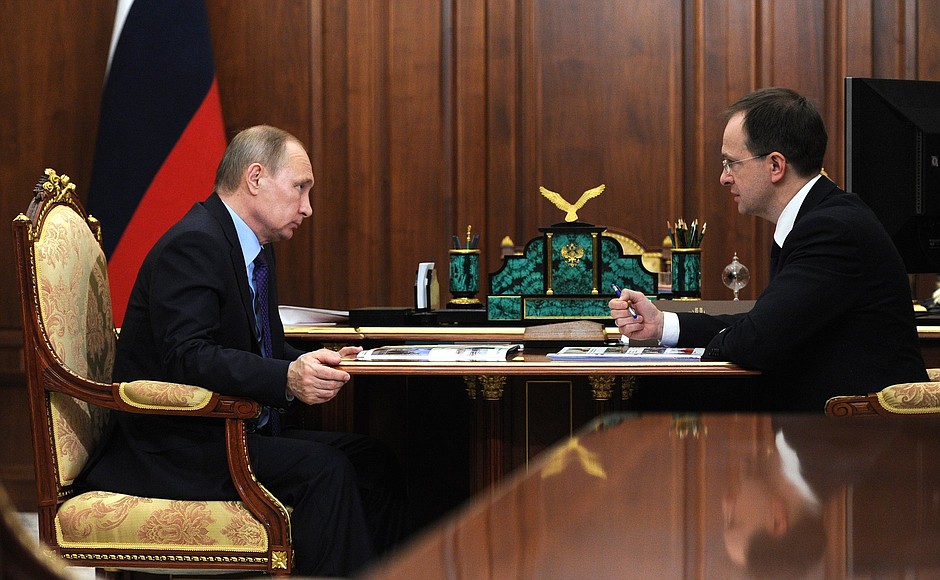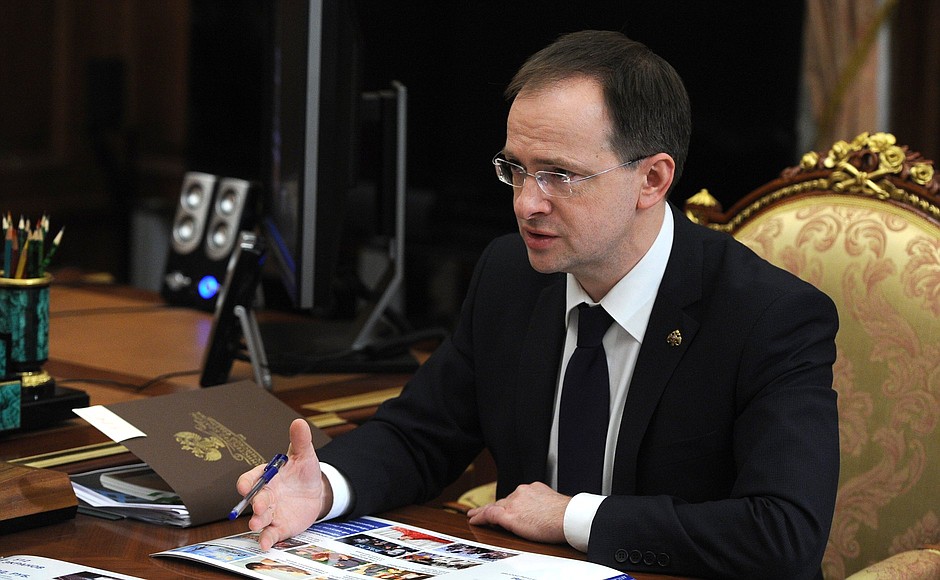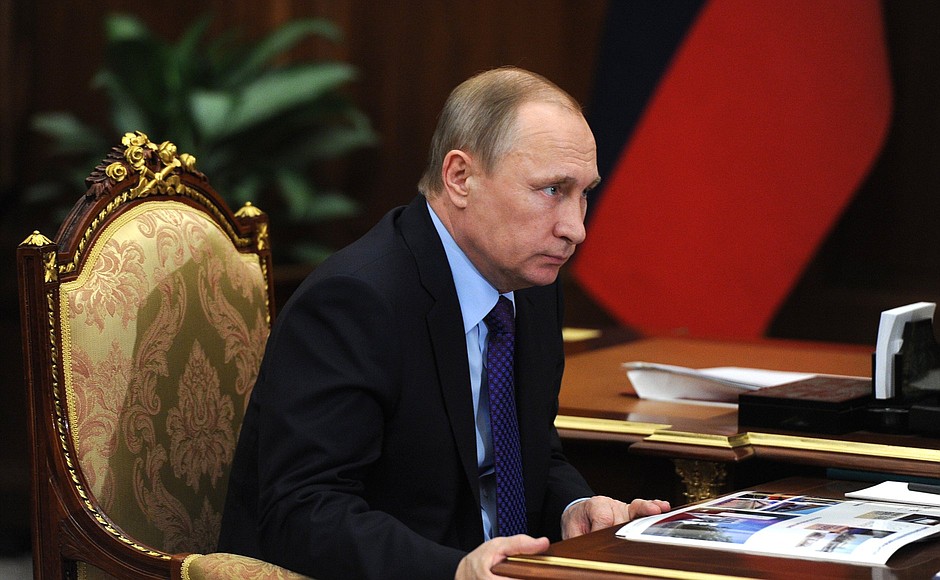President of Russia Vladimir Putin: Mr Medinsky, the year 2016 has been declared the Year of Russian Cinema. As far as I understand, this is what we will be discussing today. What does the Ministry of Culture intend to do in this respect? What are your plans? What initiatives would you like to implement? What support measures can be extended to the movie industry?
Minister of Culture Vladimir Medinsky: Mr President, this is our third Humanities year in a row: in 2014, we held the Year of Culture; 2015 was the Year of Literature; and 2015 is the Year of Cinema. Of course, this entails great responsibility and is a major challenge for the Ministry. Our efforts are very proactive in this respect. Let me start by briefly describing the current state of affairs.
In 2012, Russian movies accounted for 16 percent of all films distributed in the country. Over the last three years, we have been able to increase this share to 18 percent and keep it at this level despite a number of challenges that I will highlight later in the meeting. Our objective is to reach 25 percent in 2018.
What else has been achieved? The main achievement is that we have made ticket sales 100 percent efficient and transparent. There was no such framework before and this issue used to be a serious sticking point. But now the Americans are able to request Russian statistics so that they can gain an insight into how their movies are selling in Russia.
In addition, although much is being said about the statist bias when it comes to government support for the movie industry, nevertheless in terms of the artistic value of Russian films you can see that the number of awards at international film festivals has increased substantially. In fact, it has more than doubled. This is another important performance indicator for us.
Speaking about the current Year of Cinema, it is possible to describe an endless number of events, over 3,000 festivals and screenings all over the country. But there are also some large-scale events that we will hold regularly, for instance Cinema Night. Starting this year, we will show Russian films for free in streets, squares and parks. For instance, during the St Petersburg International Economic Forum, Russian films will be shown on Palace Square for several days to the live accompaniment of the Mariinsky Theatre Orchestra and Sergei Prokofiev’s best music.
And, of course, investment in infrastructure is the main thing. First, in April we are opening what Hollywood was always proud of – a live studio at Mosfilm. Moscow of the 19th century will be built there. Furthermore, three years ago you took a decision to restore Lenfilm Studios. In May, Lenfilm will open its new production shops and pavilions. I will be pleased to invite you to its opening ceremony.
At the end of this year, Soyuzmulfilm will finally move its production capacities to its own building next to Ostankino. We will be pleased to invite you to the opening ceremony as well.
The main and most ambitious programme during the Year of Cinema ‒ or to be more precise, we will start carrying it out in the Year of Cinema – is support for film screenings in small cities. You remember well that in Soviet times every regional centre ought to have one winter and one summer cinema theatre. Regrettably, since then film theatres only remained in million-strong cities or, at best, in regional centres. A third of the country’s population doesn’t even have the opportunity to see films.
That is why this year we launched a programme of government subsidies to open modern cinemas that can show premieres in small cities with a population under 100,000. In all, we plan to have 512 new, modern cinemas. For three years, half of the showings at these cinemas will be of Russian films. We are doing it for ourselves, not for Hollywood.
In all, we allocated a total of 2.5 billion rubles to the Cinema Fund for these purposes. These are not some additional funds; we understand money is tight. We found it in the Ministry of Culture’s reserves. The first cinemas have already opened, for instance, the Sphere in Chechnya. They did it very fast – literally in several months. Have a look at the pictures: Chechnya and Tatarstan.
In addition, we are opening movie theatres in circuses and in culture centres that are being built as per your executive orders of May 7, breathing some life into these centres. Oddly enough, circuses stand empty between shows. But now we will show there, accordingly, exclusively children’s films.
And now to the [State Central] Cinema Museum, which lost its premises 20 years ago. We began the museum’s rehabilitation with a building located at VDNKh, one that will now house both the museum and a cinema house. We plan to open the renovated building in early 2017. It is a large project.
As for film-making, the first thing we did was to approve a minimum quota for supporting children’s film production, which has been neglected these past few years, as well as for supporting animated films. Taken together, these funds amounted to 25 percent of the total. Soon after this investment, our children’s films started winning prizes and making a lot of money. We take pride in our animated films; they attract huge audiences; they are a unique Russian product.
TV series are another achievement. It was once believed that such series were low-life films, as their characters were either criminals or families in distress. We decided to pool our efforts with TV networks to support for-TV series that would be otherwise unprofitable, such as adaptations of classical novels or expensive series of a particular historical period. The first joint productions by TV networks and the Ministry of Culture include And Quiet Flows the Don, Demons by Dostoyevsky, Fadeyev’s The Young Guard, and Catherine the Great. We launched these series.
And what was the result? Our audiences, which once seemed to have grown used to cheap soap operas, now eagerly watched these new TV series. These series’ audiences were the biggest possible. The TV networks were astonished that our TV audiences had retained a great deal of their good taste.
As per your instruction, we have compiled a list of the best 100 must-see children’s films. We have freed them of copyright liability and posted them, offering free access to them on our website www.culture.ru, the site of the Ministry of Culture and Education. Unfortunately, it’s difficult for children to find spare time to watch these films, but since these films are very good additional materials for studying Russian history and literature, we decided to show these films for free at movie theatres, which now will be providing a valuable social service. Moreover, cinema administrations offer 12- to 15-minute lectures before these films about the history of Soviet filmmaking. I have shown some of these films to my kids, and they have learned to appreciate old Soviet films because they now know how and why they were made.
In addition, a unique project has been launched to help people with visual or hearing impairments to access cinemas. A law to this effect has been initiated and approved in the first reading. With time, all cinemas will be equipped with special seats where people with disabilities will be able to see and hear a film using special amplifying and magnifying devices. In fact, no solutions of this kind exist anywhere in the world.
Finally, the Year of Russian Cinema is advertised in all types of media, including outdoor advertising, TV ads, online and via social media. All these efforts are implemented with the help of our partners and do not require any investment from the budget. For instance, Aeroflot has named five airliners in its fleet after prominent Russian cinematographers. The Moscow metro is working with the Ministry of Culture to redesign 10 trains, and the first one of them, dedicated to the Gorky Film Studio, is already in service on the Circle Line. Other trains will celebrate Soyuzmultfilm and the winners of the Moscow Film Festival. Russian Railways will name 12 inter-city trains after Russian film stars.
In conclusion, I would like to say a few words about the funding of the Russian film industry before highlighting some of the issues it faces.
Funds earmarked for the film industry understandably tend to decrease. At the same time, we introduced a new mechanism three years ago that literally saves us. Companies now return part of the funds we invest in the film industry, which was not the case before. These returns enable us to compensate for lower allocations, and our budget has even slightly increased.
Last year, we invited you to the new, wonderful building of VGIK, the Russian State University of Cinematography. It has opened and is now up and running. Even the Russian Cinema Fund now has a small building on Tverskaya Street, in the very centre of Moscow. This building used to be operated as a private business centre.
Vladimir Putin: Good.
<…>



